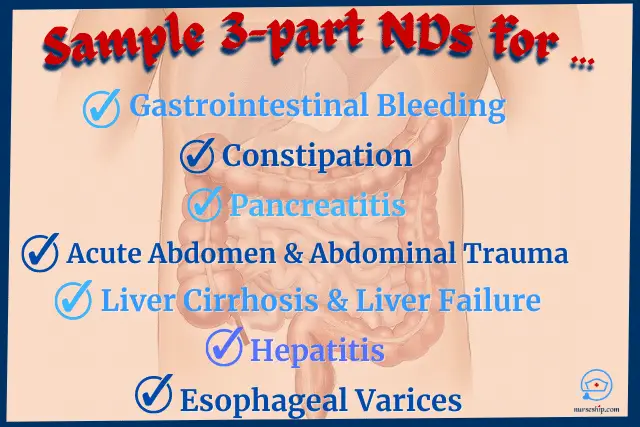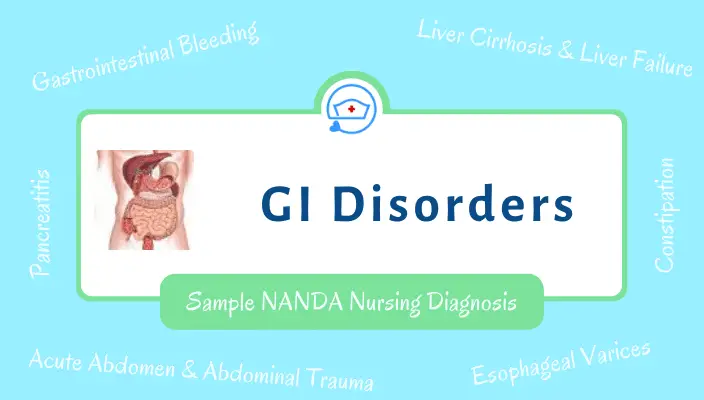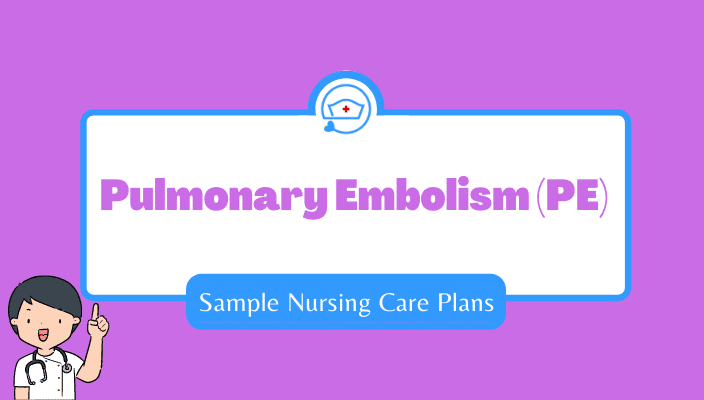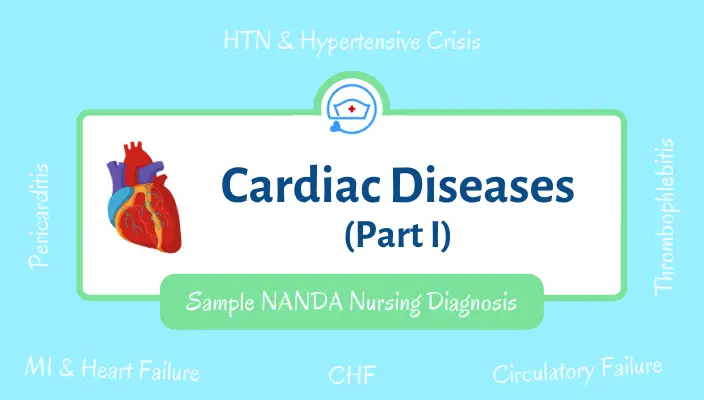Here, we’ll list down few sample nursing diagnoses for Gastrointestinal (GI) disorders. These sample nursing diagnoses are standard NANDA three-part NDs for the following GI disorders.
Namely,
Gastrointestinal Bleeding Constipation Pancreatitis Acute Abdomen and Abdominal Trauma Liver Cirrhosis and Liver Failure Esophageal Varices
Sample Nursing Diagnosis for Gastrointestinal (GI) Bleeding
Related to As evidenced by gastrointestinal hemorrhage hypotension, tachycardia, decreased skin turgor, weakness, decreased urinary output, pallor, diaphoresis, seconds, altered mental status, restlessness, coffee-ground emesis, black stool
Fluid volume deficit Related to As evidenced by acute gastrointestinal hemorrhage, hypovolemia, hypoxia, vasoconstrictive therapy decreased blood pressure, increases heart rate, decreased peripheral pulses, abnormal ABG values, severe abdominal pain, decreased urine output, confusion, mental status changes, dyspnea, loss of consciousness
Related to As evidenced by muscle spasms, ulceration, gastric mucosal irritation, presence of invasive lines verbalization of pain, facial grimacing, changes in vital signs, abdominal guarding
Related to As evidenced by nausea, vomiting, nasogastric tube inability to ingest adequate amounts of food
Related to As evidenced by new environment, change in health status, life-threatening health crisis irritability, restlessness, anxiousness, fearfulness, tremors, tachycardia, tachypnea, diaphoresis
Related to As evidenced by lack of information, lack of understanding of medical condition statements of misinformation, questioning about disease process
Related to As evidenced by ignoring the urge to defecate, lack of physical activity, irregular defecation habits, depression, emotional stress, certain medicines (e.g: NSAIDs, iron therapy), rectal abscess/ ulcer, pregnancy, rectal anal fissures, hemorrhoids, obesity, insufficient fiber intake, insufficient fluid intake inability to pass stool, presence of hard stool in the rectum, visible fecal impaction on x-ray image, palpable masses on LLQ
Related to As evidenced by accumulation of hard stool in the colon verbal report of pain, presence of hard stool in the rectum, tenderness, nausea, vomiting, abdominal cramps, facial grimacing, crying, diaphoresis, moaning
Related to As evidenced by excessive straining, fissures, hemorrhoids –
Related to As evidenced by pancreatic obstruction, autodigestion of pancreas, inflammatory process reporting of severe epigastric pain, patient curled up with both arms over abdomen, nausea, vomiting, tenderness, facial grimacing, crying, moaning, diaphoresis, increased WBCs, increased body temperature
Related to As evidenced by emesis, fever, diaphoresis, nasogastric drainage several episodes of vomiting, increased body temperature, presence of continuous nasogastric drainage, decreased urine output
Related to As evidenced by nausea, vomiting, nasogastric tube, digestive enzyme leakage, sepsis inability to ingest adequate amounts of food, anorexia, increased metabolism, lack of adequate food ingested
Related to As evidenced by complications from disease –
Related to As evidenced by decreased insulin production, increased glucagon release, stress –
Related to As evidenced by altered peristalsis, change in pH level, nutritional deficiencies, tissue destruction, chronic disease –
Related to As evidenced by trauma, infectious process, surgery grimacing, guarding of the affected part, reports of pain, restlessness, shallow respirations, abdominal rigidity
Related to As evidenced by perforation of abdominal structures, laceration of vasculature, open wounds, peritoneal cavity contamination –
Related to As evidenced by Complications of trauma, invasive procedures –
Related to As evidenced by fluid shifts, hemorrhage, nasogastric drainage –
Related to As evidenced by trauma, surgery, nasogastric drainage prolonged NPO, increased metabolic rate, electrolyte imbalance
Related to As evidenced by metabolic changes, malabsorption of fats and vitamins anorexia, nausea, vomiting, weight loss, fatigue, edema, ascites, increased ammonia level
Related to As evidenced by compromised regulatory mechanism, decreased plasma proteins, excess sodium, fluid intake pitting edema, weight gain, intake greater than output, oliguria, dyspnea, BP changes, abnormal electrolyte levels, change in mental status
Related to As evidenced by poor nutrition, altered circulation, altered metabolism, bile deposits on skin presence of edema, ascites, jaundice, pruritus, skin breakdown
Related to As evidenced by increased pressure from ascites, hyperammonemia, decrease lung expansion, fatigue presence of ascites, dyspnea, tachypnea, shortness of breath, altered arterial blood gases
Related to As evidenced by altered clotting factors, esophageal varices, portal hypertension –
Related to As evidenced by changes in physical appearance presence of ascites, negative feelings about physical appearance, fear of rejection
Related to As evidenced by Alcohol abuse, hyperammonemia, abnormal liver function –
Related to As evidenced by lack of recall, lack of understanding of disease process verbalization of incorrect statements, asking for information, development of preventable complications
Related to As evidenced by decreased stamina lethargy, malaise, diminished muscle strength
Related to As evidenced by leukopenia, immunosuppression, malnutrition, exposure to causative organisms
Related to As evidenced by bile salt accumulations on skin yellowish skin, pruritus, itching, scratching
Related to As evidenced by metabolic changes, anorexia nausea, vomiting, anorexia, abdominal pressure, malabsorption of fats, weight loss, fatigue, edema
Related to As evidenced by disease process, self-imposed physical isolation, inadequate support system expression of feelings loneliness rejection, absence of family members and friends, sad, inappropriate behaviors, withdrawal, no communication, no eye contact
Related to As evidenced by lack of information, disease process, unfamiliarity of resources requests for information, statements of misperceptions, development of preventable complications
Related to As evidenced by new environment, disease process expressions of shame, irritability apprehension,
Related to As evidenced by variceal bleeding decreased blood pressure, increased heart rate, weakness, decreased urinary output, pallor, diaphoresis, decreased capillary refill, altered mental status, restlessness
Related to As evidenced by variceal bleeding, hypovolemia, hypoxia decreased peripheral pulses, hypotension, tachycardia initially, bradycardia, cold and clammy skin, diaphoresis, loss of consciousness, lethargy, pallor, abnormal ABG values, decreased oxygen saturation, decreased urine output
Related to As evidenced by variceal bleeding feeble peripheral pulses, hypotension, tachycardia, cold and clammy skin, decreased urinary output, loss of consciousness, dyspnea
Related to As evidenced by muscle spasms, gastric mucosal irritation, presence of invasive lines verbalization of pain, facial grimacing, changes in vital signs, guarding
Related to As evidenced by new environment, life-threatening health crisis irritability, agitation, apprehension, tremors, tachycardia, tachypnea, diaphoresis
Related to As evidenced by lack of information, lack of understanding of disease process verbalization of incorrect statements
Related to As evidenced by disease process anxiety, fear, hostility, manipulative behavior, guilt, rationalization, blaming behavior
Related to As evidenced by use of balloon tamponade to control esophageal bleeding, tube migration, air leakage, esophageal necrosis, airway occlusion, asphyxia –
Note:
Reference Comer, S. and Sagel, B. (1998). CRITICAL CARE NURSING CARE PLANS . Skidmore-Roth Publications.
Gulanick, M. and Myers, J. (2014). NURSING CARE PLANS: Diagnoses, Interventions, and Outcomes (8th ed.). Elsevier/Mosby.
Herdman, T. and Kamitsuru, S. (2018). NURSING DIAGNOSES: Definitions and Classifications 2018-2020 (11th ed.). Thieme.
Swearingen, P. (2016). ALL-IN-ONE CARE PLANNING RESOURCE (4th ed.). Elsevier/Mosby.





